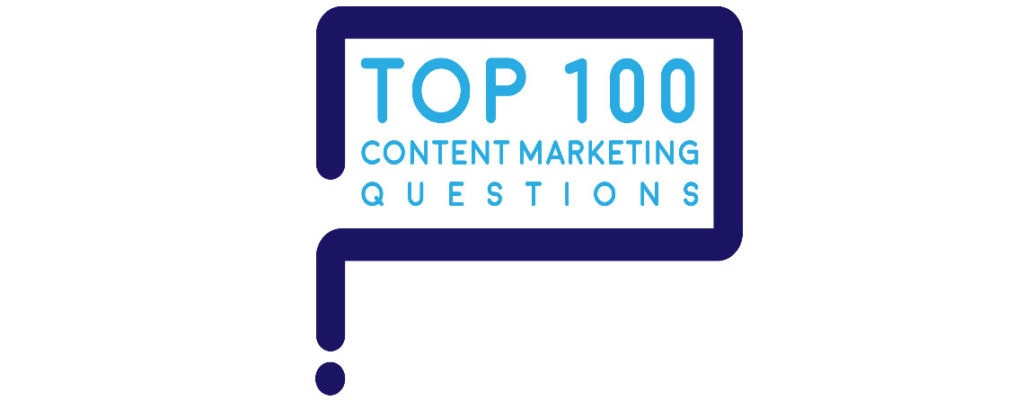
Top 100 Content Marketing Question: How to sell the value of content marketing to Sales?
How to sell the value of content marketing to Sales?
A marketer asked in a recent workshop:
“How do you sell the value of content marketing to Sales? When they don’t see a direct correlation to a sale?”

Here are 10 proven ways that content marketing can help generate sales and revenues. Each will help you gain Sales buy-in.
Thanks to Amy Young at Cisco for the great question.
Remember: Sales is coin-operated.
Anything that puts more money in their wallets, Sales will embrace – including content marketing.
Look at your business through the eyes of Sales. You see that only 3 things matter – customers, revenue and sales commissions.
Does content marketing help Sales:
- Find good customers?
- Nurture and close deals?
- Collect commissions?
Content marketing is pivotal to all these needs. Successful marketers:
- Help Sales see how buyer behaviors are changing.
- Involve Sales in co-creating a content marketing platform.
- Convert content marketing assets into useful face-to-face sales tools.
- Share the risk and credit for results such as sales, customers and revenue.
1. Reveal how buyer behaviors are changing.
Customers use online resources to perform up to 80% of the buying process, but that activity may be invisible in Sales.

Help sales people see new buyer behaviors by prompting them to reflect on their own purchases. Ask someone who bought a car or house how they found the right one:
- What questions did they have?
- Did they use search?
- What did they discover?
- Did they find answers to their questions online?
- At what point in the process did they call a salesperson?
Help Sales realize that their customers now take a similar approach to buying, looking online to research any carefully considered purchase.
2. Enlist Sales to brainstorm customer questions.
Prompt Sales to write down every question they’ve ever heard from a buyer. Even if you need to incent them to do so with a contest or spiff, it’s worthwhile.

For content marketing, knowing customers’ real questions is golden. With customer questions in hand, Marketing can create the best answer to each customer question, one at a time.
Make each question into a separate blog or post. With one question and one answer, each webpage can maximize its presence in a Google search.
Don’t list a whole bunch of questions on a single FAQ page. Why?
Any webpage with multiple questions and answers covers too many different topics to gain a good Google ranking. That’s why FAQ pages can’t be discovered by buyers.
If you have an existing FAQ page, tear it to pieces. Create a series of posts with one question, one answer per webpage.
3. Show Sales that content is all about making buyers smarter.
The best salespeople already know that their job is to teach buyers how to make smarter decisions. Content marketing does the same job: it makes buyers smarter.
Offer buyers the best answers to their questions through your content. In parallel, equip Sales with the same assets in the form of sales support materials.
Keep your company on message by delivering the same consistent message through Marketing, Sales, Customer Service and executives. That’s especially important when there’s a long sales cycle of 12 months, 24 months or more.
4. Involve Sales in co-creating a content marketing platform.
To gain the organizational buy-in you need, build a strategic foundation for content marketing together with Sales and other key players. Convene everyone who has a stake in the success of Sales and Marketing.
Specifically, enlist Sales to help co-create your:
- Content marketing mission statement
- 1-page content marketing strategy
- Message Map.
These are 3 of the 7 essential steps to Fast-Forward Your Content Marketing.
Find a facilitator to help the team co-create a content marketing mission, strategy and Message Map.
Many companies can complete the first drafts in one long work day. Others may take 2 or 3 days.
The co-creation process demands a significant investment of everyone’s time up front. Then it saves time throughout the year for Marketing and Sales by aligning the team around its mission, strategy, and message.
When people co-create a content marketing platform together, they build a springboard to success for content marketing.
5. Convert content into useful tools for Sales.
Tie Sales directly into your content distribution. With thought-provoking content, you can create significant leverage for Sales.

For example, at Tellabs, we created a controversial, thought-provoking industry analyst study for our mobile service provider customers. The study showed that customers were on a path to becoming unprofitable in as little as 90 weeks.
We published this study as a news release, video, infographic and more, the week before a big trade show, Mobile World Congress.
The study, based on solid facts and third-party analysis, generated big debates and oversized news coverage.
It led to inbound calls from customers that the company had never even talked to before, including calls from the CTO office at Telefonica and from Google. Unexpected inbound customer calls really turned heads in Sales.
We went one step further to integrate Sales into content marketing: Any customer who wanted to see the complete analyst study had to meet with Sales face to face.
Why? Only Sales had copies of the complete analyst study to share. Creating scarcity helped to open doors for Sales.
This content marketing won a Content Marketing Award for Tellabs. Much more important, it opened doors to new customers and demonstrated the value of content marketing to Sales.
Tellabs’ follow-up content offered customers ways to solve the profitability problem, showing them how to reduce network costs and remain solidly profitable.
What content can you create to be delivered by Sales, face to face? How tightly can you integrate Sales into your digital, print and live event content?
6. Create a message to address customers’ unconsidered needs.
Tell a provocative story about customers’ unconsidered needs that leads naturally to your solution. Why?
Addressing unconsidered needs:
- Adds urgency to your message.
- Makes it stand out from others in the eyes of buyers.
- Increases message uniqueness by 50%.
- Leads logically to your solution.

While Sales and Marketing often see competitors as their biggest threat, “The true competitor is the status quo,” Tim Riesterer says.
A whopping 60% of B2B sales opportunities lead to no purchase decision. Instead, the status quo prevails.
That’s why it’s crucial for Marketing and Sales to sell against the status quo in addition to selling against competitors. Successful salespeople help customers understand what’s the real problem and why they need to make changes.
Specifically, show customers:
- Why the status quo is untenable
- What are the hidden sources of friction, costs and penalties
- How much those disadvantages will grow in the future.
The payoff? “74% of executives buy from the seller who helps them see the need to change. Create a ‘why change?’ discussion,” Riesterer says.
7. Provide Sales with visibility into the buyers’ journey.
Use marketing automation to track individual buyers’ content usage and share that data with Sales.
When you bring a lead to Sales, include the history that’s otherwise invisible to them:
- Which pieces of content did the customer consume?
- What topics are they most interested in?
- How quickly are they consuming content?
Don’t underestimate buyers’ willingness to consume content, especially on carefully considered purchases.
As buyers consume content, they prequalify themselves. The more content they consume, the more likely they will buy.

At River Pools and Spas, Marcus Sheridan required new sales prospects to read 35 pages of content and watch a video before he would schedule a sales call about a swimming pool. Why?
Because prospects who did not consume the content closed only 5% of the time. Prospects who consumed all that content closed at an 80% rate.
As Sheridan observes, by the time a customer consumes a lot of content, they either love you or hate you. The ones who love you are easy to close. The ones who hate you go away, so they don’t waste Sales’ time.
Sales becomes much more productive when customers qualify themselves by consuming big doses of content. For more, see Sheridan’s book They Ask You Answer.
Ask the head of Sales how valuable any increase in the sales closing rate could be for your company.
8. ‘Choke’ the bottom of the marketing funnel.

This sounds counterintuitive: Stop giving Sales all your marketing-qualified leads.
Give Sales fewer leads. Make sure each lead is of the absolute highest quality. Put quality first, not quantity. Why?
If you send Sales 100 good leads, they may call 5 or 10. If they don’t close a deal in the first 5 or 10 tries, they won’t take time to follow up the other leads.
So instead of sending Sales 100 leads, send 20 fantastic leads instead. Improve the odds that Sales will close on one or more leads.
Ask Sales regularly for feedback on each lead. Did they consider it qualified? Why or why not? Use Sales’ feedback to further refine your demand generation process.
When Sales starts to close deals and earn commission dollars from the leads that Marketing provides, they gain confidence in Marketing as a partner. That adds momentum to the Sales and Marketing partnership.
Once you’ve proven the quality of your leads to Sales, it’s time to stop choking the funnel and provide more marketing-qualified leads.
9. Share the risk and the credit.
Propose a revenue quota for Marketing. How much revenue will your content marketing generate over the next year?
Show executives that Marketing is willing to have its feet held to the fire with a quota, just like Sales. Demonstrate that Sales and Marketing are working together to generate customers, revenue and profits. Even a skeptical CEO will pay attention to that.
Celebrate every Sales success. Give full credit to each salesperson who closes a deal that started with a marketing-qualified lead.
Soon, other salespeople will envy those successes. They’ll come to you for help.
10. Choose the most promising places to start content marketing.

Three places you can start working with Sales on content marketing are short-cycle sales, orphans and greenfields.
A short-cycle sale is one where customers make decisions faster, so revenue comes in quicker and commissions are paid sooner. That’s why it’s a great place to start content marketing.
For example, in the network equipment market, telecom buyers take 12 to 30 months to reach buying decisions. But electric utilities can reach a decision in only 3 to 6 months.
That’s why, at Tellabs, we launched a content marketing pilot project with electric utilities instead of telecom companies. Utilities’ quicker buying decisions meant we could close sales faster, book revenue earlier, and prove the effectiveness of content marketing quicker.
An orphan is a product or a market that historically has gotten zero marketing support. It has potential, but it’s suffering from neglect. Most big companies have one or more orphan products or businesses.
Adopt an orphan by providing content marketing support. As the orphan’s sales rise over time, Sales will clamor for content marketing on additional products.
A greenfield is a brand-new opportunity such as a new market or a new product. Take a risk: Launch the new market or product solely with content marketing. By doing so you can attribute all the new product’s sales to content marketing.
Next step: Start a pilot project with Sales to advance content marketing.
Don’t wait for permission! You can always seek forgiveness later.
These 10 ideas offer you and your Sales partners lots of upside.
You can get Sales aboard as a partner in content marketing by helping them win more customers, deals and commissions.
Great content marketing helps customers, Marketing, Sales and your company win more often. That’s what it’s all about.

Related Posts
Spending up, activity up, effectiveness down: content marketing study
There’s encouraging news in the latest B2B content marketing study from the Content Marketing Institute and Marketing Profs. More B2B marketers are using content marketing...
Top 100 Content Marketing Question: How do you get buy-in for a content marketing strategy?
Here are 4 ways to get buy-in for a content marketing strategy: Build a big tent to co-create strategy. Educate about why the company...
3 Content Marketing Blind Spots Where Accidents Begin
As you drive, risks arise in your blind spots: • That car that you didn’t see just behind you in the right lane. •...
3 Reasons To Create Content Marketing From Customer Questions
Most communications and marketing consists of statements. So how can content marketers add questions to improve buyers’ understanding of content? Open-ended, thought-provoking questions make...





